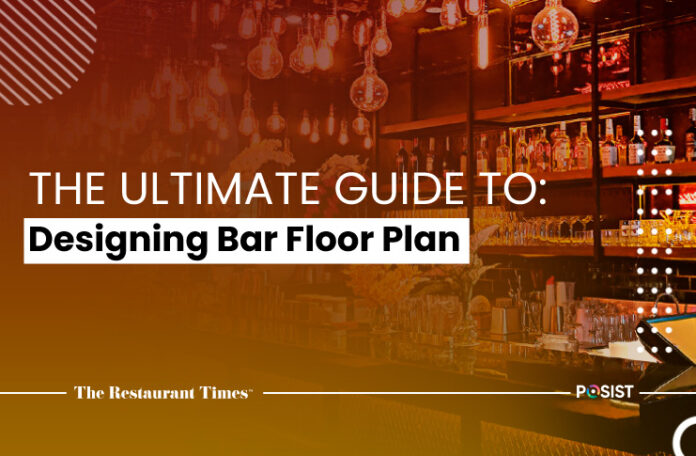A well-thought-out bar floor layout considers all the important logistics and rules, makes your bar appear welcoming to clients, aids in smooth service, and keeps everything organized. All things considered, your floor layout can significantly affect your setup and operating costs as well as the overall customer experience.
What are these ‘all things’ that you should consider? Well, for starters, a bar’s floor plan should be accessible to all guests and provide enough space for customers. Additionally, many states require blueprints for building permits, thus a restaurant floor plan is both important and necessary.
In this article, we take you through all the steps to help you design the perfect bar floor plan and enhance your guest experience. But first, let’s clarify what a bar floor plan exactly is.
What is a Bar Floor Plan?
A bar floor plan is a map of the physical area of the entire bar, including the dining room, ordering queue, washroom, kitchen, dish station, prep rooms, storage, and any outdoor space. It helps you visualize how all of your bar’s spaces will fit together.
Bar areas are a better use of room than large waiting areas or entryways because your guests can buy drinks as they wait to be served. Additionally, since customers are accustomed to bars being smaller than conventional tables, this type of setting requires less dining room space.
Even if you have limited space, a bar or countertop dining area can be quite profitable in terms of income generation. So, how do you cash in on this? Let’s see what you need to create a floor plan for bars.
Key Requirements for a Bar Floor Plan
A bar’s floor plan provides an overview of your complete space and can help you figure out how to make the best use of the available space while also creating pathways for the simple mobility of customers and personnel. A well-designed bar floor plan will have the following elements:
- Full bar
- Kitchen
- POS system and cashier station
- Entrance
- Restrooms
- Seating area
- Entertainment area
- Emergency exit
- Staff office
Additionally, you should plan the back of the bar and open areas alongside your bar’s floor to ensure that all spaces flow well. Although, if you feel there is room for improvement, you can always tweak things a little.
Along with layout, the lighting of your bar is an important factor that you should be taking into account because it affects how your bar feels and how appealing your cuisine looks. For example, your diners may be uncomfortable if you make the mistake of placing tables too close to huge spotlights. Additionally, if the light is too dim, they might not be able to appreciate the bar’s ambiance and its vibe.
How to Create a Bar Floor Plan?
Designing a floor plan can be challenging, especially if you are beginning from scratch. You might feel overwhelmed by the amount of work you have to complete and unsure of where to begin. But, here are some suggestions that can be helpful as you go through this challenging process that demands a lot of planning and time:
- Adhere to the Local Government Guidelines: In many states, a floor plan must be submitted to the city to obtain a permit for the development of a new bar. Therefore, make sure to check with your local government agency to learn about all the requirements so that everything, such as building codes, is taken into account from the onset of your design stage.
- Decide Your Bar’s Aesthetic: When you begin planning a bar, you should have comprehensive discussions with your team to gain clarity on the brand, identity, and type of impression and experience you want your bar area to convey. The service approach, cuisine, and appearance of the bar must all work together to attract consumers who match your intended target audience.
- Layout Your Future Plans: Would you rather invest in the best materials and avoid future repairs, or would you rather build your bar one step at a time and cost-effectively? To answer these questions, keep your short- and long-term goals in mind. When determining where and how to spend money throughout the restaurant floor plan design process, consider a ten- or twenty-year business strategy.
Tools for Creating a Bar Floor Plan
Here are a few automated tools that will make the entire process of creating a bar floor plan simple, while bringing your vision to light:
- SmartDraw: With sophisticated formatting and designer templates, SmartDraw markets itself as a diagramming app. Additionally, it has tools that let you create and publish scale architectural and engineering designs. If you want to use it to design a floor plan, you may choose a template and add symbols to make something clean and helpful. It’s also useful for designing flowcharts, which you can use to map out your company’s activities or systems. SmartDraw is available for both Windows and Mac users.
- RoomSketcher: RoomSketcher develops floor plans and drawings for a variety of projects, including home decor and office design. It’s designed to be user-friendly, even for those with no professional experience, and it works on Mac, Windows, and tablets. Alternatively, you can have a floor plan designed for you by the RoomSketcher professionals.
- CAD Pro: With more than 2.5 million users worldwide, CAD Pro is one of the most widely used computer-aided design tools. Although CAD for Windows is intended for designing residential or business spaces, it has many capabilities that make it possible to create stunning floor plans. On the website, you may also discover a few sample blueprints to get you started. But, remember that utilizing CAD requires a certain degree of experience and may be challenging to use for a beginner.
- FloorPlanner.com: This interactive floor plan builder is simple to use and helps you design floor layouts to scale that can then be downloaded. It includes a range of visually appealing surface designs and symbols. With just one click, you can designate zones for your café, bar, lobby, or restroom. You can then select colors and materials, as well as add and arrange fixtures and fittings—most crucially, tables—and other design elements.
Another alternative is to hire a design firm to assist you in materializing your vision. A professional designer will be able to develop a coherent aesthetic for your bar while also working with you to enhance the guest experience.
Top Bar Floor Plan and Design Layout Ideas
Designing a bar floor design is a difficult process that requires a lot of organization and time. But don’t worry because here are some layout and design ideas to help you design the perfect floor plan for your bar:
Entrance Floor Plan
The entrance gives your guests their first impression of your bar, so aim to create an entrance that feels welcoming to your customers. It should provide enough information to help them navigate your bar.
Also, don’t neglect the waiting area. The waiting area is where your guests will be hanging around before being seated at the bar. If this space is uncomfortable for them, it can upset them. So the very least you can do is offer them comfy chairs rather than forcing them to stand and obstruct the entrance.
Kitchen Floor Plan
Most designers prioritize the kitchen before moving on to planning the other sections of a restaurant because even though bar kitchens are likely to be small, they cannot be overlooked. Cooking in a small kitchen is unpleasant for everyone, therefore, you should carefully design your floor’s layout to make the most out of the available area.
An ideal kitchen floor plan should allow ample space for your chefs to prepare and plate food, as well as for equipment storage.
Staff Room Floor Plan
Your bar’s floor layout should incorporate staff areas like administrative offices and break rooms. Set aside an area towards the bar’s back end for your management to conduct administrative chores and for all of your employees to unwind during breaks.
Additionally, designating a staff space can help keep your bar organized by offering a single location to post employee timetables or other updates.
POS System and Cashier Station Floor Plan
The quantity and placement of your restaurant’s POS software can have a significant impact on your business operations. Ideally, they should be positioned in areas that are convenient for servers to access and not block their movement. You can set up a cashier station along the bar, and a few additional ones around the seating area.
Alternatively, you might also invest in handheld POS machines that your servers and bartenders can take to your guests to reduce time.
Restroom Floor Plan
When it comes to creating a restaurant floor plan, the restrooms are often the most overlooked element. Almost all your guests will use the restroom at least once while they are there, thus it adds to their overall impression of your restaurant. Therefore, design restrooms that are spacious enough for visitors to use and simple to access from the main seating area.
Also, ensure that your guests don’t have to walk past the staff areas to use the restroom.
Conclusion
Your bar’s floor plan governs the workflow of your whole operation, from the kitchen and dining space to guest amenities like the waiting lounge and restroom. Ideally, a bar’s floor plan should promote the free movement of staff personnel, customers, and food throughout the restaurant.
Although, when it comes to constructing a floor plan, keep in mind that there is no one-size-fits-all solution, and the best floor layout is determined by your bar’s style and sales volume.
Related Readings:
















